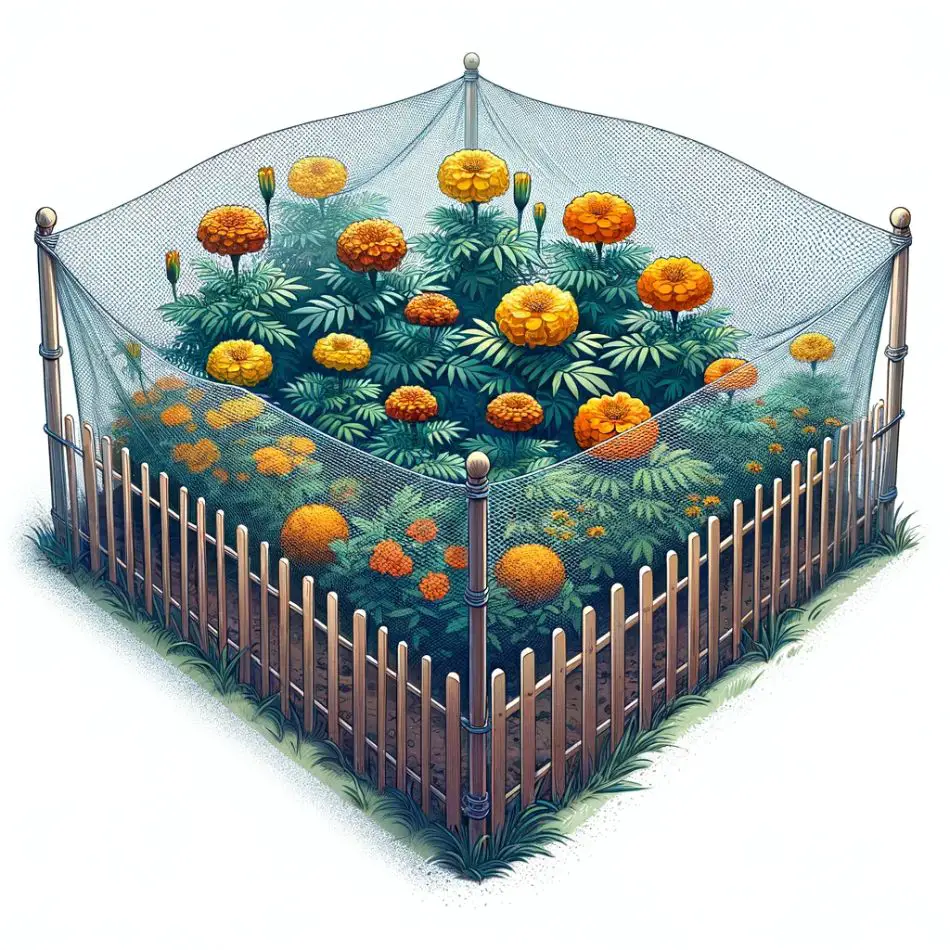Marigolds, known for their vivid colors and ease of care, are a staple in many gardens. These flowers not only enhance the beauty of a landscape but also have practical uses, such as pest control. But, do deer eat marigolds?
Yes, deer can eat marigolds, especially when their preferred food sources are scarce. While marigolds are not a favorite due to their strong scent and taste, hungry deer might resort to eating them under conditions of limited food availability, making marigolds not completely deer-proof.
This article aims to explore the complex relationship between deer and marigolds, shedding light on whether these flowers are a likely target for deer and what measures can be taken to protect them.
Deer’s Dietary Habits and Preferences

Deer are known for their adaptable and diverse diet, which plays a significant role in their interaction with garden plants, including marigolds.
Primary Food Sources
Primarily herbivorous, deer’s diet consists of a variety of plants, fruits, nuts, and tender shoots. Their eating patterns are largely guided by the seasons – feasting on lush greenery in spring and summer, and turning to twigs, bark, and evergreens during scarcer winter months.
This seasonal shift in diet reflects their ability to adapt to available food sources, ensuring survival across different environments.
Factors Influencing Dietary Choices
Several factors influence a deer’s dietary choices. Availability is key; in areas abundant with food, deer will opt for the most nutritious and palatable options. Environmental conditions, such as drought or snow cover, can limit their choices and push them to seek alternative food sources.
Nutritional needs, particularly in times of growth or pregnancy, also drive deer to seek specific types of food.
Deer’s Interaction with Garden Plants
In gardens, deer’s flexible diet means that they may occasionally feed on flowers like marigolds, especially when their preferred foods are scarce.
While marigolds are not typically their first choice due to their strong scent and taste, hungry deer in a nutrient-deprived environment might resort to eating them. Understanding these dietary habits is crucial for gardeners aiming to protect marigolds and other susceptible plants from deer.
Marigolds: Between Deer-Resistance and Repellence
Marigolds exhibit characteristics that place them between being deer-resistant and repellent. Deer resistance implies that deer, in general, tend to avoid these plants, but this does not guarantee immunity from deer grazing.
On the other hand, repellence indicates an active deterrence, usually due to specific features of the plant that are unappealing to deer. Marigolds possess a distinct fragrance and texture that are not favored by deer, contributing to their deer-resistant nature.
However, this resistance is not absolute. In situations where food is scarce, deer might overlook their aversions and feed on marigolds. The effectiveness of marigolds as a deer repellent is also influenced by their density in the garden.
A higher concentration of marigolds might emit a stronger scent, thereby functioning more effectively as a repellent. It’s important for gardeners to understand that while marigolds can deter deer to some extent, they should not be solely relied upon as a foolproof method to prevent deer from entering a garden.
Varieties of Marigolds and Their Resistance to Deer

Marigolds, with their spectrum of colors and forms, encompass a variety of species, each with unique characteristics that influence their resistance to deer.
Factors Contributing to Deer Resistance
The primary factors that contribute to a marigold’s resistance to deer are its scent and texture. Marigolds release a pungent aroma, which is often unappealing to deer. Moreover, the texture of the leaves and petals can also deter deer, as they prefer smoother, softer foliage for consumption. Varieties of marigolds exhibit different levels of these traits, influencing their attractiveness to deer.
Overview of Popular Marigold Varieties
Some popular marigold varieties known for their deer resistance include:
- African Marigolds (Tagetes erecta): These marigolds are known for their large, vibrant blooms and a strong scent that is particularly effective in repelling deer. Their robust size and dense foliage make them less appealing for deer to nibble on.
- French Marigolds (Tagetes patula): Smaller than their African counterparts, French marigolds emit a potent fragrance that deer find off-putting. Their finely cut foliage is also less palatable to deer, contributing to their resistance.
- Signet Marigolds (Tagetes tenuifolia): These marigolds are known for a sweeter, citrus-like aroma and delicate foliage. While still somewhat deer-resistant, they may be more susceptible to deer grazing compared to more pungently scented varieties.
Considerations for Gardeners
When selecting marigolds for a deer-prone garden, gardeners should consider the variety’s scent and texture. Planting more pungently scented and roughly textured marigolds can effectively reduce the likelihood of deer damage.
It’s also beneficial to plant these marigolds in groups, as a concentrated area of strong scent can create a more substantial deterrent. Consulting with local nurseries can provide insights into the best marigold varieties for specific regions and deer populations.
Signs of Deer Activity in Gardens

Identifying deer activity in gardens is crucial for implementing effective strategies to protect plants, including marigolds. Recognizing the signs of their presence can help gardeners take timely action.
Physical Evidence of Deer
Deer leave distinct physical evidence in gardens. One of the most noticeable signs is hoof prints, especially visible in soft soil or mud. These prints are typically heart-shaped, with two pointed toes forming a split in the center.
Another clear sign is damage to plants. Deer tend to eat plants in a rough manner, often leaving jagged edges on leaves and stems, and in some cases, entire plants may be stripped of foliage. This type of damage, especially on higher plants, often differentiates deer from smaller animals like rabbits or groundhogs.
Furthermore, well-worn paths or trails through garden foliage can indicate regular deer movement.
Deer Scat Identification
Deer scat is another indicator of their presence. It typically appears as small, pellet-like droppings, often found in clusters. The presence of these pellets near garden beds, especially those containing marigolds, can signify that deer have been foraging in the area.
Behavioral Indicators
Deer behavior, including feeding patterns and movement, can also provide insights into their activity. Deer are generally more active during dawn and dusk. Observing these patterns, along with any seasonal changes in behavior, can help gardeners anticipate and mitigate potential damage.
For instance, increased deer activity is often noted in early spring and late fall, coinciding with new plant growth and preparation for winter, respectively.
Recognizing these signs of deer activity is a crucial step for gardeners in protecting their plants. Timely identification allows for the implementation of appropriate measures to minimize the impact of deer in gardens.
Also see Do Deer Eat Lettuce?
Effective Strategies to Protect Marigolds from Deer

Gardeners cherish marigolds for their vibrant beauty, but these flowers often fall prey to deer. Protecting marigolds requires a multifaceted approach, combining physical barriers, natural repellents, technological innovations, and behavioral strategies to effectively deter these persistent grazers.
Physical Barriers: Fencing and Netting
Fencing is a primary line of defense against deer. A fence must be at least 8 feet tall to prevent deer from jumping over, and using materials like wire or solid wood can enhance its effectiveness. The placement of the fence is crucial, surrounding the marigold bed or the entire garden perimeter for optimal protection.
For gardeners seeking a less permanent solution, netting offers a flexible alternative. Draping netting over marigold plants can create a physical barrier, deterring deer while allowing sunlight and rain to reach the flowers. This method is particularly useful for smaller gardens or individual flower beds.
Natural Repellents: Plant Choices and Homemade Sprays
Incorporating deer-resistant plants around marigolds can naturally deter deer. Plants like lavender, rosemary, and sage emit strong scents that are unappealing to deer, creating an aromatic shield around marigolds.
Additionally, gardeners can create homemade deer repellent sprays using ingredients like garlic, chili pepper, and peppermint oil. A simple recipe involves mixing crushed garlic and chili peppers in water, letting it steep for a few days, and then spraying it around marigolds.
These natural repellents provide an environmentally friendly way to protect marigolds without harming the deer.
Technological Deterrents: Motion-Activated Devices
Motion-activated devices offer a modern approach to deer deterrence. Sprinklers that activate upon detecting movement can startle deer, discouraging them from approaching marigold beds. Similarly, motion-activated lights can create a sense of human presence, further deterring nocturnal visits.
Ultrasonic deer repellers emit high-frequency sounds, imperceptible to humans but uncomfortable for deer, providing an additional layer of protection.
Behavioral Strategies: Altering Deer Patterns
Finally, altering deer behavior and patterns can be effective. Regularly changing the layout of deterrents and employing various strategies in rotation can prevent deer from becoming accustomed to static defenses.
Introducing unpredictability in the garden layout and deterrent deployment can create an environment that deer perceive as unsafe, encouraging them to seek food elsewhere.
Implementing these strategies can significantly reduce the likelihood of deer damaging marigolds. By combining physical barriers, natural repellents, technological innovations, and behavioral tactics, gardeners can enjoy the full bloom of their marigolds without the fear of deer predation.
Conclusion: Balancing Beauty and Practicality
In summary, while marigolds are not inherently deer-proof, they do possess qualities that can make them less appealing to these animals. Understanding the nuances of deer behavior, the varying resistance of different marigold varieties, and the effective use of deterrents can help gardeners maintain the beauty of their marigolds without significant deer damage.
By balancing the aesthetic appeal of these vibrant flowers with practical strategies to protect them, gardeners can enjoy the dual benefits of marigolds’ beauty and their role in creating a deer-resistant garden.


